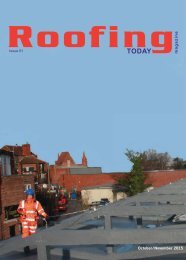Roofing
Roofing%20Today%20Issue%2065%20July%202016
Roofing%20Today%20Issue%2065%20July%202016
Create successful ePaper yourself
Turn your PDF publications into a flip-book with our unique Google optimized e-Paper software.
Health & Safety<br />
Ten Steps to Maintaining Good Health<br />
for Roofers<br />
Janine Brady - Marketing Manager, SIG <strong>Roofing</strong><br />
Thankfully today, most of us are familiar with on-site safety and the<br />
prevention of accidents at work. However, what about safeguarding<br />
against illnesses? Time means money and absenteeism due to ill<br />
health can affect not only on our livelihood, but our lifestyle too. Given<br />
the nature of roofing, we can face various health hazards, so it pays to<br />
understand how best to minimise or avoid them. So, here are ten steps<br />
to help you maintain good health.<br />
1. Manual handling: Manual handling accounts for the majority of<br />
non-fatal injuries in construction, resulting in roofers having a lot of<br />
musculoskeletal disorders - in particular back problems. As there is no<br />
actual ‘safe’ weight, legal requirements stipulate avoidance or control<br />
of risk. Therefore, it’s important to refer to the Manual Handling<br />
Operations Regulations (MHOR) for guidelines on lifting, lowering and<br />
pushing and pulling - visit www.hse.gov.uk/construction.<br />
2. Noise: To protect your hearing it’s always best to eliminate or<br />
substitute noisy processes on a construction site whenever you can.<br />
Removing people from the noisy area and choosing quieter equipment<br />
can be just as effective, however where noise can’t be avoided,<br />
hearing protection and/or hearing protection zones are legally required<br />
– find out more at www.hse.gov.uk/noise/regulations.htm.<br />
3. Vibration: If not correctly controlled, use of hand held vibrating<br />
tools like breakers, hammer drills and combihammers can lead to<br />
illnesses such as Hand-Arm Vibration Syndrome. As these tools are<br />
common place for roofers, its best to select equipment that reduces<br />
exposure to vibration and have them checked/calibrated regularly. Job<br />
rotation can also help.<br />
4. Skin: Wearing gloves and protective clothing are vital to protect<br />
our skin. However, this is not limited to use of hazardous materials,<br />
excessive exposure to the sun is a major cause of skin problems.<br />
Keeping covered, wearing a hat with a brim or a flap, staying in the<br />
shade whenever possible and using a high factor sunscreen of SPF30<br />
will help protect against the sun.<br />
5. Hygiene: It’s a legal requirement that all sites must have<br />
adequate welfare and washing facilities. Washing facilities must<br />
include a sink large enough to wash your hands, face and forearms.<br />
Hot and cold running water, soap and towels must also be provided.<br />
There should also be an area for securely storing clothing and for<br />
drying wet items, and a separate room for eating and drinking.<br />
6. Asbestos: You may come into contact with or disturb asbestos<br />
during routine maintenance work. Asbestos causes around 5,000 workrelated<br />
deaths each year in the UK and should be handled with<br />
extreme care. If you need further information on how to safely handle<br />
asbestos, visit www.hse.gov.uk/asbestos/essentials/index.htm.<br />
7. Dust: Silica occurs in many types of stone and concrete,<br />
including roof tiles and slate. It can be released during cutting or<br />
grinding, and when sweeping/cleaning work areas. Unfortunately, over<br />
500 construction workers die every year from exposure to silica dust,<br />
so it’s important to eliminate or reduce it. Wet working, avoiding high<br />
pressure spraying and wearing masks all help. For limits, view the<br />
Control of Substances Hazardous to Health (COSHH) Regulations at<br />
www.hse.gov.uk.<br />
8. Paints and coatings: these can contain a number of different<br />
substances, some of which can cause various short and long-term<br />
health issues. If not properly controlled, solvents or VOC’s within<br />
coatings can create a serious immediate risk as they give off vapours.<br />
Always select paints and coatings with low VOC content and carefully<br />
follow the application instructions, and ensure there’s plenty of<br />
ventilation.<br />
9. Hydration: Roofers are particularly vulnerable to the impact of<br />
dehydration due to extreme temperature conditions. It’s not unusual for<br />
it to reach 32°C in direct sunlight on a roof and up to 60°C in a heat<br />
wave. To stay hydrated, HSE recommends consuming around 250ml<br />
(half a pint) of water every 15 minutes.<br />
10. Zero Harm: It pays to align yourself to a supplier that has your<br />
best welfare at heart and is committed to providing excellence in<br />
health and safety. A reputable roofing supplier will be meticulous in<br />
providing only those products and services that meet all health and<br />
safety requirements; thereby giving you complete peace of mind.<br />
Good health is to the benefit of us all. By following these steps, you<br />
will not only help maintain tip-top health, you will ensure best roofing<br />
practice for the whole industry.<br />
Page 36 <strong>Roofing</strong> Today<br />
Enquiry 29




